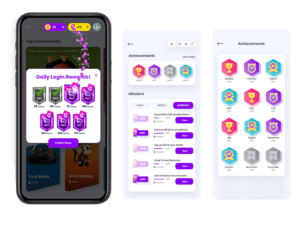Gamification is everywhere – from the witty trivia that your food delivery app pops up every once in a while, to your health tracking device pushing you to complete your ‘rings’ or compete with your peers to gain special badges. Even organizations like Microsoft and Amazon now nudge you to showcase your e-badges online after passing their certification exams.
The idea of gamification has taken very little time from its initial days as a concept to a combination of actual steps that many market leaders and large organizations have incorporated to transform their business processes and marketing effectiveness. We live in an era where the market is predominantly mobile. The recent years of the pandemic have solidified the need for entertainment to go mobile as well, with OTT (Over-the-air) video platforms projected to reach a revenue of $210 Billion by 2026. This proliferation has given rise to many competitors to traditional players like Netflix and Amazon Prime. With the average user being more and more difficult to engage, entertainment organizations are looking to bring in gamification measures to win them back. In this article, we take a look at how gamification has become a disruptive force in the world of entertainment.
How does Gamification Help in the World of Entertainment?
Gamification helps in the world of entertainment in many ways, including:
- Gamification measures are built with user engagement and interactivity in mind. Once implemented, they ensure people’s interest and participation are increased.
- Gamified processes and services attract new customers and retain existing customers.
- Milestone-based incentivization ensures returning customers stay loyal for longer durations.
- Gamification increases brand promotion, awareness and helps drive home important customer-centric messages.
- Gamification strategies like permission-based user activity tracking help gather important data, which when analyzed gives organizations greater insight into their key user demographic and apply customizations to their offerings.
- Gamified newsletters help get more email subscribers and ensure they interact regularly with emails.
Some Recent ‘Gamified’ Examples in the Entertainment Industry:
Here are some recent examples of gamification in the entertainment industry:
- OTT entertainment giants Netflix released an original movie, called Black Mirror: Bandersnatch in late 2018. This movie had something truly unique – it gave viewers interactivity by offering them story progression choices at different intervals, and based on their selections, the story arc would take twists and turns. This user engagement style was heavily influenced by the gameplay mechanics of role-playing video games (RPGs) and presented an excellent implementation of gamification. The success of this movie prompted Netflix to produce several more in the coming years. The current tally of interactive movies in Netflix sits at 18, with more in the pipeline.

- Legendary Pictures Productions, the team behind superhits ‘Godzilla’, ‘300’ and the likes, organized a custom screening for one of their movies and then used emotion recognition software on the viewers to understand scene-by-scene human emotions that their fanbase underwent while watching the movie. This data was utilized by their applied analytics division to curate their movie trailers accordingly and create a more personalized experience for viewers worldwide. This reduced Legendary’s spending in marketing by 10% and exceeded their box office opening budgets by $30 million.
- Disney has taken many gamification steps to increase fan engagement for their entertainment offerings, from partnering with game developers to release video games tied to their movie releases, to opening full-fledged, interactive theme parks. They recently opened the doors to an immersive, ultra-expensive Star Wars-themed hotel, called ‘Galactic Starcruiser’ to further bolster interest in their upcoming Star Wars movies as well as ongoing TV series, ‘Mandalorian.’
- During the marketing campaign for their 2012 movie ‘The Hunger Games, Lionsgate created an interactive website as part of the promotion. Users could log in and explore the city that they had previously experienced only in the pages of the books. A gamified competition called ‘Ultimate Fan Challenge’ was also created. Social interactions were boosted courtesy of a ‘Capitol Couture’ Instagram profile and Tumblr page, and a ‘Hunger Games’ Facebook community that hosted games, trivia, and other daily events.
—
Companies that use gamification are seven times more profitable than the ones that do not. One can argue that an industry like entertainment that thrives on audio-visual engagement requires gamification more than any other, and it is not entirely wrong. Gamification puts the focus back to the user and drives more engagement via three i’s – interaction, incentivization, and instant gratification. Organizations that have adopted early to the gamification trend are now driving the market, forcing other players in the same field to follow suit. The entertainment industry has seen major growth in the past five years, and the Covid-19 pandemic has added fuel to their upward trajectory. Gamification has provided them with the right mix of audio-visual interactivity and tangible rewards that are roping in users. If you are a market leader or a business owner, gamified entertainment may be the next big thing you are looking for.






